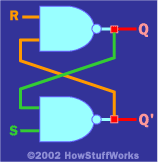Difference between revisions of "Flip Flops"
(→Edge triggered D Type Flip Flop) |
(→Basic (SR) Flip Flops) |
||
| Line 3: | Line 3: | ||
==Basic (SR) Flip Flops== | ==Basic (SR) Flip Flops== | ||
| − | [[File:Bool-rs.gif]] | + | [[File:Bool-rs.gif|200px|thumb|right|alt text]] |
Basic flip flops are created using two NAND gates cross couples as seen in the image. | Basic flip flops are created using two NAND gates cross couples as seen in the image. | ||
| + | |||
==Problems with basic (SR) flip flops== | ==Problems with basic (SR) flip flops== | ||
==Edge triggered D Type Flip Flop== | ==Edge triggered D Type Flip Flop== | ||
[[File:D-Type-ff.gif|200px|thumb|right|alt text]] | [[File:D-Type-ff.gif|200px|thumb|right|alt text]] | ||
Revision as of 10:45, 16 March 2017
Contents
[hide]What is a flip flop
A flip-flop is used to store binary data, and is a simple latching circuit.
Basic (SR) Flip Flops
Basic flip flops are created using two NAND gates cross couples as seen in the image.

